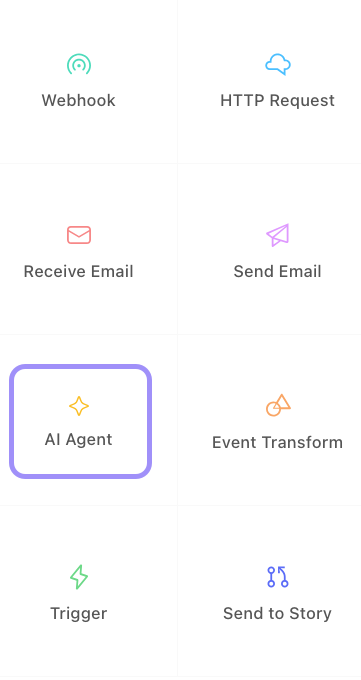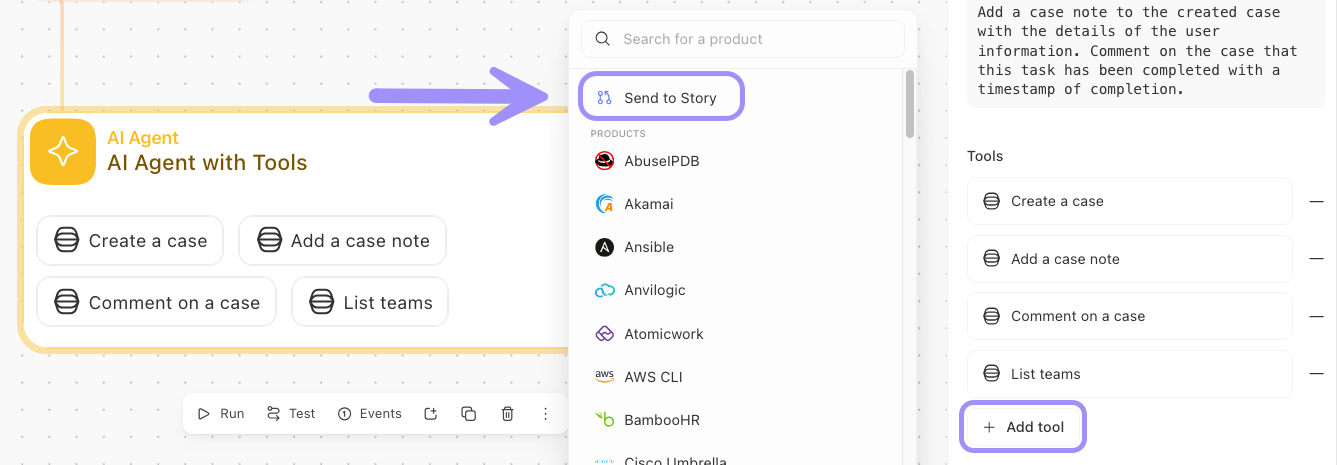The AI Agent action (also known as an AI Agent, or simply, agent) enables you to harness the power of AI within your workflows, automating tasks, enhancing user interactions, and unlocking powerful reasoning capabilities.
You control the AI Agent action's level of autonomy: use simple logic, add a human-in-the-loop, or go fully autonomous.
What can the AI Agent action help you with?
🧠 Make smart decisions in real time, using input data to choose the best course of action, even when not every possible scenario is predefined.
Example: Enrich and prioritize alerts, make sense of noisy data, and surface the most relevant information to speed up triage and resolution.
🔄 Adapt dynamically to changing information, pulling in context from various sources to tailor the AI Agent action's responses and behavior, rather than following rigid workflows.
Example: Analyze suspicious emails, helping teams quickly evaluate phishing attempts and determine next steps.
💬 Power conversational interfaces that interact directly with users, guiding them, answering questions, or helping them complete tasks through an AI-driven chat experience.
Example: Handle IT requests, such as answering common employee questions or initiating service tasks based on user input.
Find your way to the AI Agent action
Within your storyboard, locate the AI Agent action in the left-hand editor panel. Simply drag it onto your storyboard to start building!

You've got options
Monologue work with Task mode
Task mode is designed for full automation. In this mode, the AI Agent action operates autonomously, initiating, reasoning, and responding to prompts without human interaction. It acts like a monologue, thinking through a task and executing steps using any Tools or Custom Tools it has access to. This is ideal for backend workflows where you want the AI Agent action to complete tasks independently, such as processing data, generating content, or resolving support cases.
End-user interaction with Chat mode
Chat mode enables interactive, AI-powered page experiences for end-users. Builders can create customized chat interfaces that allow your end-users to engage directly with the AI, which is guided by the configuration set for the AI Agent action. This mode is best suited for collecting information, guiding users through a process, or delivering personalized responses. This is useful for stories that offer support bots, contact forms, or knowledge assistants. Chat mode also supports Tools and Custom Tools for richer functionality.
❗️Important
When to use Task mode vs. Chat mode
Task mode examples:
📝 Change Log → Release Notes. The AI Agent action transforms a raw internal changelog into customer-facing release notes, written in a user-friendly tone.
🎟️ Support Ticket Summarization. The AI Agent action summarizes long ticket threads and provides a status update with suggested next steps to reduce manual effort for support agents.
Chat mode examples:
🛡️ Security Awareness Bot. Employees interact with an AI Agent action that quizzes them on phishing emails or educates them on safe practices through a gamified conversation.
🖥️ IT Service Request Assistant. End users chat with the AI Agent action to request a new laptop, software install, or Wi-Fi help. The AI Agent action gathers necessary information and routes it to the correct team.
Set the stage
Imagine you are the producer of a theatre show, directing a cast of actors on how to perform. Providing clear, precise instructions to the cast will help your show be a huge success! Now, similar to this mindset, to get accurate results from your AI Agent action, start by configuring two key elements: System Instructions and Prompt:
The System instructions define the environment in which the AI Agent action will work. They shape how the AI Agent action should respond by setting expectations, tone, boundaries, or background knowledge. This helps ensure the AI Agent action consistently produces outputs that align with your goals, whether that’s staying within a certain domain (i.e., cybersecurity), using a specific tone (i.e., formal or friendly), or following particular rules (i.e., never making assumptions, always citing sources).
The Prompt is the set of instructions that you want the AI Agent action to carry out. It tells the AI Agent action what tasks to perform, what kind of response is expected, and what information to focus on.
Enhance the AI Agent action with Tools and Custom Tools
You can enhance an AI Agent action by adding the following Tools to its configuration: Public Templates, Private Templates, and Send to Story. To go beyond these options, you can also build a Custom Tool, which leverages our Action Groups feature. This allows you to build and reuse custom logic within the AI Agent action.
🪄Tip
Tools - Public and Private Templates
You can certainly build actions from the ground up, but to streamline your building, Tines offers ready-made Public Templates for popular products. We also offer a way to make your own via Private Templates. Both of these template features can be added as Tools to the AI Agent action to carry out its instructed tasks.

Tools - Send to Story
Teams often reuse the same tasks across multiple stories. Instead of duplicating these steps, the AI Agent action’s Send to Story option within Tools lets you call reusable “sub-stories” (from our Send to Story feature) from different workflows. These sub-stories run their actions independently and return results to the AI Agent action, keeping your automation clean and efficient.

Custom Tools - Action Groups
Find yourself adding multiple Tools for the same integration? You can leverage Custom Tools ( which utilize our action Groups feature) to build out a bundle of Tools that operate in a similar product or, execute a similar task across different products. For example, if you need to search an IP address against multiple platforms, instead of adding each integration template as a Tool, you can build a Custom Tool and insert all of those actions into one spot. This helps organize your same-product/task integrations into compartmental structures within the AI Agent action.
Bring your own AI model to the AI Agent action
You can use the Tines AI model (credits that renew monthly) or bring your own (no additional cost) to power the logic of the AI Agent action within your tenant.
To set up your own AI model provider, navigate to your tenant Settings > AI settings > Providers > Add provider:

Then, select the model you want to use by adding the Model setting (via + Options) of the AI Agent action:

Summary steps to using the AI Agent action successfully
Determine your desired outcome
Clarify the goal of your AI Agent action. What should it accomplish in your story? This could range from summarizing data to generating responses or making decisions. Having a clear outcome helps guide the design and ensures the AI Agent action delivers value to you and your team.
Identify user interaction levels
Decide how end-users will interact with the AI Agent action. Will it run fully automated in the background via Task mode, or should it ask for user input before continuing via Chat mode? Understanding the level of interaction helps you choose which mode to use, shaping your desired results.
Configure your instructions
While the System instructions set the stage, the Prompt gives direct guidance for each run of the AI Agent action. Both are vital to the success of the AI Agent action's output.
Attach key integrations
Connect your Tools that the AI Agent action will need to reference or interact with during its execution. Tools and Custom Tools help enrich the AI Agent action's capabilities and ensure it works seamlessly within your broader automation.
What will you build?
As you explore what's possible with this feature, we turn this question back to you:
What will you build with the AI Agent action?
Something valuable, time-saving, creative, or possibly, all three and more? The power is in your hands! ✨